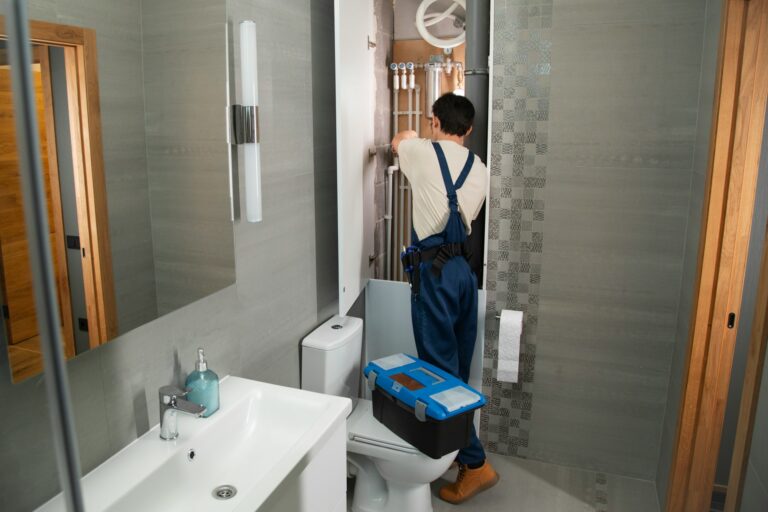Every homeowner faces plumbing issues at some point. While major repairs require professional expertise, many common problems can be resolved with basic tools and techniques. This guide covers essential DIY plumbing repairs that can save you money and time while building your confidence in handling home repairs.
Learning to tackle simple plumbing fixes empowers you to address minor issues before they become expensive emergencies. With the right knowledge and preparation, you can complete these repairs safely and effectively.
Essential Tools for DIY Plumbing Success
Basic Tool Kit Requirements
Before attempting any plumbing fixes, assemble a comprehensive toolkit. A pipe wrench, adjustable wrench, and plunger form the foundation of your collection. Add a drain snake, screwdrivers, and plumber’s tape to handle most common repairs.
Safety Equipment and Preparation
Safety should always come first during home repairs. Wear protective eyewear and gloves when working with chemicals or sharp tools. Keep a flashlight handy for working in dark spaces under sinks or behind toilets.
When to Call a Professional
Recognize the limits of DIY plumbing. Gas lines, major pipe replacements, and issues involving your home’s main water line require professional expertise. Attempting complex repairs without proper training can lead to costly damage and safety hazards.
Fixing Dripping Faucets and Leaky Taps
Identifying the Source of the Leak
Most faucet leaks stem from worn washers, O-rings, or cartridges. Turn off the water supply before disassembling any components. Examine each part carefully to identify worn or damaged pieces that need replacement.
Replacing Washers and O-Rings
Remove the faucet handle by unscrewing the packing nut. Replace the washer at the bottom of the stem and check the O-ring for wear. These inexpensive parts solve most dripping faucet problems when replaced properly.
Cartridge Replacement Process
Single-handle faucets often use cartridges that control water flow. Remove the handle and retaining clip, then pull out the old cartridge with pliers. Install the new cartridge in the same orientation to ensure proper hot and cold water function.
Unclogging Drains Without Harsh Chemicals
Manual Removal Techniques
Start with simple methods before using chemical drain cleaners. Remove visible debris from the drain opening using needle-nose pliers or tweezers. This approach often resolves minor clogs without additional steps.
Using Drain Snakes Effectively
A drain snake reaches deeper clogs that plungers cannot address. Insert the snake into the drain and rotate the handle while pushing forward. When you feel resistance, continue rotating to break through the obstruction.
Natural Cleaning Solutions
Combine baking soda and vinegar to create an effective, eco-friendly drain cleaner. Pour one cup of baking soda followed by one cup of vinegar down the drain. Cover with a plug for 30 minutes, then flush with hot water.
Toilet Repair Fundamentals
Understanding Toilet Components
Familiarize yourself with the toilet’s internal mechanisms before attempting repairs. The flapper, chain, fill valve, and flush valve work together to control water flow. Understanding their functions helps diagnose problems accurately.
Fixing Running Toilets
A running toilet typically indicates a flapper that doesn’t seal properly or a chain that’s too long or short. Adjust the chain length so the flapper closes completely after flushing. Replace the flapper if it’s warped or cracked.
Replacing Toilet Flappers and Chains
Turn off the water supply and flush to empty the tank. Remove the old flapper by unhooking it from the flush valve. Install the new flapper ensuring it creates a proper seal. Attach the chain with enough slack to allow complete closure.
Pipe Leak Solutions and Temporary Fixes
Locating Hidden Leaks
Water stains on walls or ceilings often indicate hidden pipe leaks. Check water meter readings before and after a two-hour period without water use. Increased readings suggest an active leak requiring investigation.
Temporary Repair Methods
Pipe repair clamps provide temporary solutions for small leaks until permanent repairs can be made. Clean the pipe surface and position the clamp over the leak. Tighten the screws evenly to create a watertight seal.
When Temporary Becomes Permanent
Some pipe repair products offer long-term solutions for minor leaks. Epoxy putty and pipe wrap can provide durable repairs when applied correctly to clean, dry surfaces. Follow manufacturer instructions for curing times and application methods.
Water Pressure Issues and Solutions
Diagnosing Low Water Pressure
Low water pressure can result from mineral buildup in fixtures or issues with the main water supply. Test pressure at multiple locations to determine if the problem affects the entire house or specific fixtures.
Cleaning Aerators and Showerheads
Remove aerators and showerheads to clean mineral deposits that restrict water flow. Soak components in vinegar overnight to dissolve buildup. Use an old toothbrush to scrub stubborn deposits before reassembling.
Checking for Blockages
Inspect supply lines for kinks or blockages that could reduce water pressure. Replace old, corroded supply lines with new flexible connectors. Ensure shutoff valves are fully open and functioning properly.
Preventing Future Plumbing Problems
Regular Maintenance Schedules
Implement a routine maintenance schedule to prevent common plumbing issues. Monthly checks of visible pipes, faucets, and toilet components help identify problems early. Annual professional inspections catch issues before they become emergencies.
Proper Usage Habits
Educate household members about proper plumbing usage. Avoid flushing non-biodegradable items and use drain screens to catch hair and debris. These simple habits prevent most drain clogs and toilet backups.
Seasonal Preparation
Prepare your plumbing system for seasonal changes. Insulate exposed pipes before freezing weather and know how to shut off your home’s main water supply. Seasonal maintenance prevents weather-related damage and costly repairs.
Building Your DIY Plumbing Confidence
Completing these DIY plumbing repairs builds confidence and saves money on professional service calls. Start with simple projects and gradually take on more complex tasks as your skills develop. Remember that knowing when to call a professional is just as important as knowing how to fix problems yourself.
Keep learning through online resources, home improvement books, and hands-on practice. Each successful repair adds to your knowledge base and prepares you for future challenges. With patience and the right approach, you can handle many common plumbing issues that arise in your home.
For more detailed tutorials and professional advice, click here to explore additional resources that can help you become more skilled at home repairs. Building these skills makes you a more capable homeowner while protecting your investment in your property.


